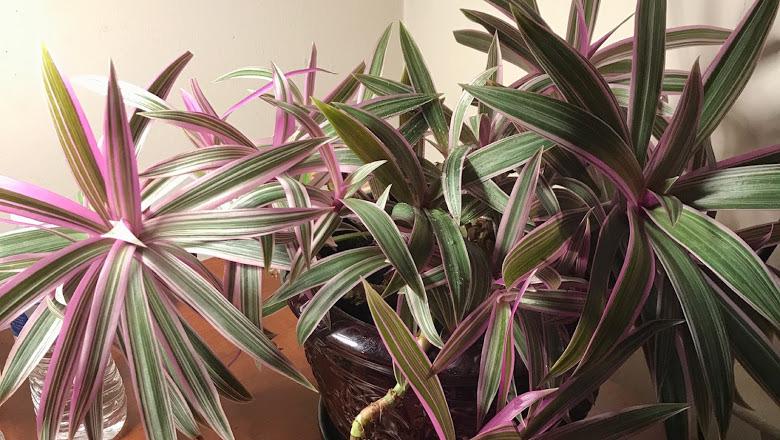Rhoeo oyster is the most beautiful tradescantia species worth adding to your indoor plant collection. Thanks to its green and purple leaves that make lasting impressions in the living areas or office. But maintaining the foliage coloration can be an intimidating experience.
So, why are the leaves of my rhoeo oyster fading? Rhoeo oyster leaves fade due to improper lighting, nutritional deficiency, overwatering, inappropriate temperature, low humidity level, natural aging, pests, and diseases.
Continue reading this rhoeo plant care to identify the exact cause of discoloration and techniques of fixing the problem. You’ll also know the rhoeo plant benefits and hidden tips related to oyster plant care. Let’s find that out together now.
You May Also Like: How to Care for Blue Star Fern

Causes of Rhoeo Oyster Leaves Fading
Indoor purple oyster leaves tend to lose color due to improper care. The ease of fixing leaves fading depends on the cause. Keep reading to learn how to identify the cause and its respective solution. (Source: Wikipedia)
You May Also Like: How to Care for China Doll Plant
Improper Sunlight Exposure
The purple oyster plant does best in bright indirect sunlight. The filtered light triggers blooming and encourage the houseplant to undertake its physiological activities.
The low-light condition makes these attractive foliages lose their vibrancy. The situation also makes this oyster plant leggy and stunted.
Be sure to relocate the houseplant to a place receiving bright indirect sunlight. Besides that, avoid direct sunlight exposure to prevent sunburn.
Lack of Humidity
The boat lily plant prefers high humidity to thrive well. But this houseplant can still tolerate indoor humidity fluctuations. Be sure to maintain indoor humidity levels above 40%.
Low humidity level causes foliage discoloration and unhealthy growth. Dry air will make the purple oyster leaves turn brown at the tips and edges.
The best solution is to mist the leaves to increase humidity around the houseplant. Another excellent option is to install a humidifier to keep the indoor environment humid.
Nutritional Deficiency
The purple oyster is a fast-growing tradescantia species with moderate fertilizer needs. Feed the houseplant every month during spring and summer.
The nutrients from well-balanced houseplant fertilizer encourage fast and healthy growth. But too much fertilizer is toxic to the houseplant.
The excess salt accumulation around the root system makes these oyster plant leaves burn. Too low nutrients and minerals in the potting soil also cause purple leaves discoloration.
I recommend re-potting the purple oyster plant in case of over-fertilization and under-fertilization. It is the best method of avoiding leaves fading problem.
Temperature Stress
Oyster plants are native to areas with a tropical climate. The warm and humid environment allows this perennial plant to thrive well outdoors.
Indoor temperature fluctuation increases the risk of hot and cold drafts. These two conditions make the attractive leaves lose their vibrancy.
Be sure to replicate the natural habitat temperature range of 55-80oF at home. Besides that, keep the plant away from door and window drafts.
Overwatering Issues
The oyster plant is among a few forgiving tradescantia species. The houseplant can tolerate drought for a couple of days without becoming fussy.
But overwatering leave the potting soil soggy and increase the risk of root rot. The plant leaves losing their vibrancy is an initial sign of root rot.
The leaves’ discoloration occurs due to insufficient absorption of vital nutrients. The damaged roots will later result in wilting and even plant death.
Transplant Shock
Oyster plants are delicate when it comes to re-potting. Any slight root disruption will make the houseplant unhappy and unhealthy.
Re-potting the indoor plant due to root-bound issues could be the reason behind the leaves discoloration problem. But the foliages usually recover for a couple of weeks.
The golden rule is to exercise ultimate oyster plant care while re-potting and growing at home to avoid leaf discoloration.
Pests and Diseases
Oyster plants are vulnerable to spider mites, mealybugs, whiteflies, and scales. These insects usually munch the leaves and inject toxins that cause discoloration.
A combination of insect infestation and plant disease tends to ruin its health and foliage vibrancy. I recommend the use of insecticidal soap to get rid of pests from the houseplant.
Besides that, reduce the watering frequency to avoid the risks associated with overwatering. It is the best method to protect the houseplant from potential plant diseases.
You May Also Enjoy: How to Care for Oyster Plant
Frequently Asked Questions
Are Oyster Plants Edible?
No. Tradescantia spathacea is not edible despite having common features with salsify plants whose roots can be eaten.
Is Oyster Plant Toxic to Pets?
No. Oyster plant foliages are non-toxic to cats and dogs. But I recommend keeping your favorite houseplant away from pets to avoid destruction.
Why Does My Rhoeo Plant Have Brown Leaves?
Rhoeo plant brown leaves occur due to direct sunlight and low humidity. The purple rhoeo thrives in bright indirect sunlight and a high humidity environment.
You May Also Enjoy: How to Care for Areca Palm
Conclusion
Rhoeo oyster is a fantastic houseplant for season growers and beginners. Indoor air purification and tropical vibes are some of the rhoeo plant benefits.
Improper oyster plant care could result in leaves losing their colors and even their death. The golden rule is to identify the exact cause and implement measures to fix it.
If the leaves of your rhoeo oysters are fading, remember to check on light and humidity levels. These are the leading cause of rhoeo oyster leaves losing colors at home.
I hope the information in this article will help you figure the exact cause of leaf discoloration and techniques of fixing it. Read through it and even recommend it to other houseplant enthusiasts.
You May Also Enjoy: How to Care for Stromanthe Triostar
